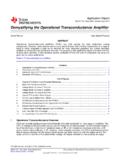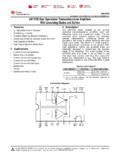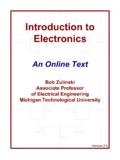Transcription of CONTENTS
1 CONTENTS . 1. Introduction 1 27. Electronics Atomic structure Structure of elements The electron Energy of an electron . Valence electrons Free electrons Voltage source Constant voltage source Constant current source Conversion of voltage source into current source Maximum power transfer theorem Thevenin's theorem Procedure for finding thevenin equivalent circuit Norton's theorem Procedure for finding norton equivalent circuit Chassis and ground. 2. Electron Emission 28 37. Electron emission Types of electron emission Ther- mionic emission Thermionic emitter Commonly used thermionic emitters Cathode construction . Field emission Secondary emission Photo electric emission. 3. Gas-Filled TTubes ubes 38 47. Gas-filled tubes Conduction in a gas Cold-cath- ode gas diode Characteristics of cold-cathode diode Applications of glow tubes Hot-cathode gas diode Thyratron Applications of Thyratron.
2 (vii). 4. Atomic Structure 48 54. Bohr's atomic model Energy levels Energy bands . lmportant energy bands in solids Classification of solids and energy bands Silicon. 5. Semiconductor Physics 55 75. Semiconductor Bonds in semiconductors Crystals . Commonly used semiconductors Energy band description of semiconductors Effect of tempe- rature on semiconductors Hole current Intrinsic semiconductor Extrinsic semiconductor n -type semiconductor p-type semiconductor Charge on n- type and p -type semiconductors Majority and minority carriers pn -junction Properties of pn -junction Applying voltage across pn junction Volt-ampere characteristics of pn-junction . Important terms Limitations in the operating conditions of pn-junction. 6. Semiconductor Diode 76 124. Semiconductor diode Crystal diode as a rectifier . Resistance of crystal Diode Equivalent circuit of crystal diode Crystal diode equivalent circuits.
3 Lmportant terms Crystal diode rectifiers Half-wave rectifier Output frequency of Half-wave rectifier . Efficiency of half-wave rectifier Full-wave rectifier . Centre-tap full-wave rectifier Full-wave bridge rectifier Output frequency of full-wave rectifier Efficiency of full-wave rectifier Faults in centre-tap full-wave rectifier Nature of rectifier output . Ripple factor Comparison of rectifiers Filter circuits Types of filter circuits . Voltage multipliers Half-wave voltage doubler Voltage stabilisation Zener diode Equivalent circuit of zener diode Zener diode as voltage stabiliser . Solving zener diode circuits Crystal diodes versus vacuum-diodes. 7. Special-Purpose Diodes 125 140. Zener diode Light-emitting diode (LED) LED voltage and current Advantages of LED Multicolour LEDs Applica- tions of LEDs Photo-diode Photo-diode operation . Characteristics of photo-diode Applications of Photo- diodes Optoisolator Tunnel diode Tunnel diode oscilla- tor Varactor diode Application of varactor diode.
4 Shockley diode. (viii). 8. Transistors 141 191. Transistor Naming the transistor terminals Some facts about the transistor Transistor action Transistor symbols Transistor as an amplifier Transistor connections Common base connection . Characteristics of common base connection . Common emitter connection Measurement of leakage current Characteristics of common emitter connection Common collector connection Comparison of transistor connections . Commonly used transistor connection Transistor as an amplifier in CE. arrangement Transistor load line analysis Operating point Practical way of drawing CE circuit Output from transistor amplifier Performance of transistor amplifier Cut off and saturation points Power rating of transistor . Determination of transistor configuration Semiconductor devices numbering system Transistor lead identification Transistor testing . Applications of common base amplifiers Transistors versus vacuum tubes.
5 9. Transistor Biasing 192 239. Faithful amplification Transistor biasing lnherent variations of transistor parameters Stabilisation Es- sentials of a transistor biasing circuit Stability fac- tor Methods of transistor biasing Base resistor method Emitter bias circuit Circuit analysis of emit- ter bias Biasing with collector feedback resistor- Voltage divider bias method Stability factor for po- tential divider bias Design of transistor biasing cir- cuits Mid-point biasing Which value of to be used Miscellaneous bias circuits Silicon versus germanium Instantaneous current and voltage waveforms Summary of transistor bias circuits. 10. Single Stage TTransistor ransistor Amplifiers 240 279. Single stage transistor amplifier How transistor amplifies? Graphical demonstration of transistor amplifier Practical circuit of transistor amplifier Phase reversal Input/output phase relationships and equivalent circuits.
6 Load line analysis Voltage gain emitter resistance . Formula for emitter resistance Voltage gain of CE. amplifier Voltage gain of unloaded CE amplifier Voltage gain of CE amplifier without CE Input impedance of CE. amplifier Voltage gain stability Swamped amplifier Classification of amplifiers amplifier equivalent circuit Equivalent circuit with signal source . Gain and transistor configurations. (ix). 11. Multistage TTransistor ransistor Amplifiers 280 305. Multistage transistor amplifier Role of capacitors in transistor amplifiers lmportant terms Properties of db gain coupled transistor amplifier Transformer coupled amplifiers Direct-coupled amplifier Com- parison of different types of coupling Difference be- tween transistor and tube amplifiers. 12. Transistor Audio Power Amplifiers 306 334. Transistor audio power amplifier Small-signal and large-signal amplifiers.
7 Output power of amplifier Difference between voltage and power amplifiers Per formance quantities of power amplifiers Classification of power amplifiers . Expression for collector efficiency Maximum collector efficiency for series-fed class A amplifier . Maximum collector efficiency of transformer coupled class A power amplifier Important points about class A power amplifier Thermal runaway Heat sink . Mathematical analysis Stages of a practical power amplifier Driver stage Output stage Push pull amplifier Maximum efficiency for class B operation Complementary-symmetry amplifier . 13. Amplifiers With Negative Feedback 335 363. Feedback Principles of negative voltage feedback in amplifiers Gain of negative voltage feedback amplifier Advantages of negative voltage feedback Feedback circuit Principles of negative current feedback Current gain with negative current feedback Effects of negative current feedback Emitter follower analysis of emitter follower Voltage gain of emitter follower Input impedance of emitter follower Output impedance of emitter follower Applications of emitter follower Darlington amplifier .
8 14. Sinusoidal Oscillators 364 388. Sinusoidal oscillator Types of sinusoidal oscillations . Oscillatory circuit Undamped oscillations from tank circuit Positive feedback amplifier Oscillator . Essentials of transistor oscillator Explanation of barkhausen criterion Different types of transistor oscillators Tuned collector oscillator Colpitt's (x). oscillators Hartley oscillator Principles of phase shift oscillators Phase shift oscillator Wien bridge oscillator Limitations of LC and RC oscillators . Piezoelectric crystals Working of quartz crystal Equivalent circuit of crystal . Frequency response of crystal Transistor crystal oscillator. 15. Transistor TTuned uned Amplifiers 389 410. Tuned amplifiers Distinction between tuned amplifiers and other amplifiers Analysis of paralled tuned circuit Characteristics of parallel resonant circuit Advantages of tuned amplifiers Why not tuned amplifiers for low frequency amplification?
9 Frequency response of tuned amplifier Relation between Q and bandwidth Single tuned amplifier Analysis of tuned amplifier equivalent circuit of tuned amplifier Double tuned amplifier Bandwidth of double-tuned amplifier Practical application of double tuned amplifier Tuned class C amplifier Class C operation and loads Maximum output power. 16. Modulation And Demodulation 411 441. Radio broadcasting, transmission and reception Modulation Types of modulation Amplitude modulation Modulation factor Analysis of ampli- tude modulated wave Sideband frequencies in AM. wave Transistor AM modulator Power in AM wave- Limitations of amplitude modulation Frequency modulation Theory of frequency modulation Com- parison of FM and AM Demodulation Essentials in demodulation diode detector radio re- ceivers Types of radio receivers Stages of superhetrodyne radio receiver Advantages of superhetrodyne circuit FM receiver Difference be- tween FM and AM receivers.
10 17. Regulated Power Supply 442 467. Ordinary power supply lmportant terms . Regulated power supply Types of voltage regu- lators Zener diode voltage regulator Condition for proper operation of zener regulator Transis- tor series voltage regulator Series feedback voltage regulator Short-circuit protection Tran- sistor shunt voltage regulator Shunt feedback voltage regulator Glow-tube voltage regulator Series triode voltage regu- (xi). lator Series double triode voltage regulator IC voltage regulators Fixed positive voltage regulators Fixed negative voltage regulators Adjustable voltage regulators Dual-tracking voltage regulators. 18. Solid-State Switching Circuits 468 505. Switching circuit Switch Mechanical switch Electromechanical switch or relay Electronic switches Advantages of electronic switches Important terms Switching transistors Switching action of a tran- sistor Multivibrators Types of multivibrators Transistor astable multivibrator Transistor monostable multivibrator Transistor bistable multivibrator Differen- tiating circuit Integrating circuit Important applica- tions of diodes Clipping circuits Applications of clip- pers Clamping circuits Basic idea of a clamper Posi- tive clamper Negative clamper.



